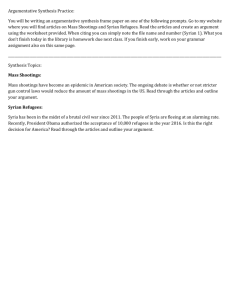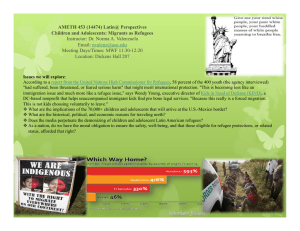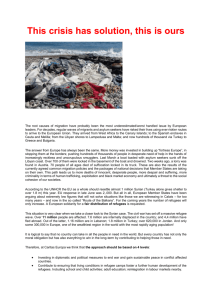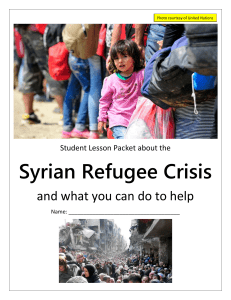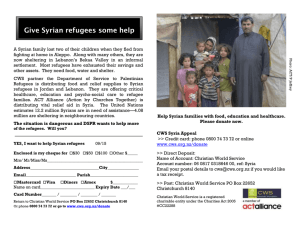-3-
advertisement
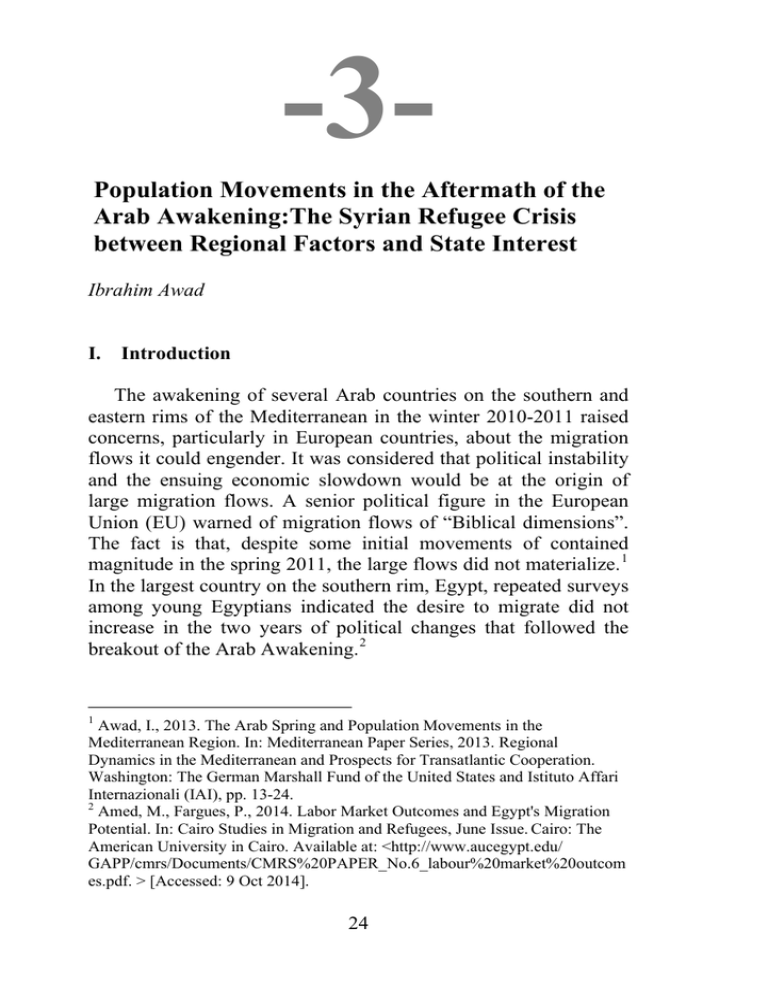
-3Population Movements in the Aftermath of the Arab Awakening:The Syrian Refugee Crisis between Regional Factors and State Interest Ibrahim Awad I. Introduction The awakening of several Arab countries on the southern and eastern rims of the Mediterranean in the winter 2010-2011 raised concerns, particularly in European countries, about the migration flows it could engender. It was considered that political instability and the ensuing economic slowdown would be at the origin of large migration flows. A senior political figure in the European Union (EU) warned of migration flows of “Biblical dimensions”. The fact is that, despite some initial movements of contained magnitude in the spring 2011, the large flows did not materialize. 1 In the largest country on the southern rim, Egypt, repeated surveys among young Egyptians indicated the desire to migrate did not increase in the two years of political changes that followed the breakout of the Arab Awakening. 2 1 Awad, I., 2013. The Arab Spring and Population Movements in the Mediterranean Region. In: Mediterranean Paper Series, 2013. Regional Dynamics in the Mediterranean and Prospects for Transatlantic Cooperation. Washington: The German Marshall Fund of the United States and Istituto Affari Internazionali (IAI), pp. 13-24. 2 Amed, M., Fargues, P., 2014. Labor Market Outcomes and Egypt's Migration Potential. In: Cairo Studies in Migration and Refugees, June Issue. Cairo: The American University in Cairo. Available at: <http://www.aucegypt.edu/ GAPP/cmrs/Documents/CMRS%20PAPER_No.6_labour%20market%20outcom es.pdf. > [Accessed: 9 Oct 2014]. 24 Rather than towards the north, the Arab Awakening generated huge population movements at the East of the Mediterranean basin, within the Arab Near East region and in its immediate neighborhood. In Syria, revolts of large parts of the population against the political regime in power soon turned into an open civil strife. Refugee flows to bordering and neighboring countries started, first accelerated and then reached enormous proportions. Considering the sizes and volumes of the population of Syria and its bordering countries, the Syrian refugee crisis stands out as unprecedented, at least in recent history. The volumes of flows and their destinations deserve attention. They bring out the challenges the crisis raises concerning the ability of host countries to provide all the necessities for the needs and livelihoods of the Syrian refugees. They also bring to the surface its possible repercussions for the stability of host countries and of the whole regional state system. Possible repercussions for the stability of host countries, in turn, determined the policies of their governments and the reactions of their constitutive communities towards the Syrian refugees. In some countries, especially Jordan and Lebanon, demographic and political stability are intimately related. Inability to meet the needs of refugees threatened and compounded with the threats they constituted for host countries and for the region. International cooperation was the indicated instrument to buttress the means of these countries. Regional and external powers stepped in to provide financial resources to the host countries and to international intergovernmental and nongovernmental organizations that assisted in meeting the needs of refugees for shelter, services and livelihoods. Through international cooperation, these powers were also expected to relieve the pressures on host countries by resettling a number of refugees in their territories. In reviewing volumes and distribution of Syrian refugees as well as policies and reactions in their respect of host countries and 25 communities and the regional and international response to the crisis, two assumptions are made. The first assumption is that historical and geographic factors interacted with states’ interests to fashion policies and reactions to the Syrian refugee crisis. The second assumption is that little international cooperation was a means to preserve the national interest of donor countries and, to some extent, that of host countries. II. Volumes and Distribution of Syrian Refugee Flows As soon as they broke out in spring 2011, the hostilities in the Syrian civil strife produced Internally Displaced Persons (IDPs) and refugees. By the end of 2012, 647,000 refugees were distributed over Lebanon, Jordan, Iraq and Turkey, as well as Egypt. In 2012, the flight of the Syrians was the largest annual exodus by a single refugee group since 1999. At the time, Syria itself was still hosting Iraqi refugees, estimated by the Syrian Government at 534,000. 3 This was a smaller number of Iraqis than a year earlier. Some Iraqis had returned to their home country, which must have now looked to them as less violent than Syria, a perception obviously shared by those Syrians who had headed to Iraq. The growth rate of Syrian refugees was appallingly spectacular. Six months later, by mid-2013, their number reached 1.9 million, among whom 1.8 million were assisted by UNHCR, in addition to 4.3 million IDPs. In that first half of 2013, from among the 1.3 million new refugees, Lebanon received 440,000, Jordan 390,000 and Turkey 290,000. During these six months, Syrians accounted for eight out of every 10 new refugees. 4 Flows continued what seemed like their unstoppable growth. A year later, by June 2014, according to UNHCR estimates, total persons of concern to the agency had reached 2.8 million, among whom 3 UNHCR, 2013. Displacement, The New 21st Century Challenge. In: UNHCR Global Trends 2012. Geneva: UNHCR. [pdf] Available at: < http://www.unhcr.org/51bacb0f9.html > [Accessed 9 Oct 2014]. 4 UNHCR, 2013. Displacement, The New 21st Century Challenge. In: UNHCR Mid-Year Trends 2013. Geneva: UNHCR, pp. 7,21. [pdf] Available at: < http://www.unhcr.org/52af08d26.html > [Accessed 9 Oct 2014]. 26 some 70,000 were still unregistered. Lebanon hosted 1.1 million, Jordan 600,000, Iraq 220,000, Turkey 760,000 and Egypt 140,000. 5 In UNHCR estimates, by mid-2013, Jordan and Lebanon were the third and fourth major refugee-hosting countries, after Pakistan and Iran. 6 A year later, Lebanon overtook Iran, as the second largest refugee-hosting country while Jordan remained in fourth place but approximating the third in terms of numbers of refugees. In accordance with the same estimates, by the end of 2012, Jordan was the first country in the world in terms of number of refugees per 1,000 inhabitants, at 49, well ahead of Chad, at 33. Lebanon ranked third with 32. 7 With the growth in volumes of Syrian refugees in mid-2014, Lebanon moved to first place, with over 250 refugees per 1000 inhabitants, well ahead of the second, Jordan, with 88. 8 UNHCR estimates do not provide a complete picture of the situation. The configuration of the region, its history and the particular relations between its countries and their populations allow movements and stay without notifying hosting authorities. It is thus estimated that in Lebanon, in addition to the 1.1 million, some 600,000 to 750,000 have also taken refuge there, which would take the number of refugees per 1,000 inhabitants there to 360. Jordan, which is now second after Lebanon, was the first country in terms of number of refugees per 1,000 inhabitants at the 5 UNHCR, 2014. Syria Regional Refugee Response. [online] Available at: < http://data.unhcr.org/ syrianrefugees/regional.php > [Accessed 9 Oct 2014]. 6 UNHCR, 2013. Displacement, The New 21st Century Challenge. In: UNHCR Mid-Year Trends 2013. Geneva: UNHCR, p 7. [pdf] Available at: < http://www.unhcr.org/52af08d26.html > [Accessed 9 Oct 2014]. 7 UNHCR, 2013. Displacement, The New 21st Century Challenge. In: UNHCR Global Trends 2012. Geneva: UNHCR, p. 15. [pdf] Available at: < http://www.unhcr.org/51bacb0f9.html > [Accessed 9 Oct 2014]. 8 Calculations of the author. It is worth noticing that persons of concern to UNHCR in both Jordan and Lebanon do not include Palestinian refugees. Obviously, if these were accounted for, the numbers of refugees per 1,000 inhabitants in Lebanon and Jordan would still be higher. 27 end of 2012, at 49. In Egypt, the government estimates the total number of Syrian refugees at 300,000. The volumes of refugees relative to the populations of host countries are sufficient to signal the enormous financial and economic burdens they constitute. These burdens, history, the power of states and the relations between communities determined their policies and reactions to the Syrian refugee flows. In the meantime, until January 2013, only about 64,000 Syrians had sought asylum in EU member states. These accounted for 2.4 per cent of the total number of Syrians who had fled their country. From among the applications, 60 per cent had been made in Germany and Sweden. 9 III. State Policies and Community Reactions to the Syrian Refugee Crisis Historical and geographic factors seem to have interacted with the rationale of states’ interests to determine national policies towards the Syrian refugee crisis. The former factors look like having also fashioned community reactions to the crisis. Syria, Lebanon and Jordan are states of recent formation, which, independently of administrative partitions, constituted one political unit until the third decade in the 20th century. Syria and Lebanon became independent in 1943 and it is only past the middle of the century that the customs union between the two countries was broken. Iraq belonged to the same political extension. On either sides of the borders drawn up and put in place in the first decades of the last century, with the collapse of the Ottoman Empire, live the same communities and tribes. Turkey is 9 Chulov, M., Grant, H., 2014. Fortress Europe: Keeping Migrants Out at What Cost?, The Guardian, 13 Jan 2014, [online]. Available at < http://www.theguardian.com/world/2014/jan/13/syrian-refugee-catastropheeuropean-union-united-nations/print > [Accessed 9 Oct 2014]. 28 a regional power and a large part of inhabitants of its Hatay province, bordering with Syria, are Arabic speaking. Long claimed by the Syrian state, Hatay was, according to the French mandate and the 1923 Treaty of Lausanne, the Liwa Iskanderoun part of Syria that was annexed by Turkey in 1939. 10 Although no policies were explicitly announced by Lebanon and Jordan regarding the Syrian refugee flows, the two countries kept their borders open. The territorial extension and community solidarities across borders made it natural for Syrians to seek refuge in Lebanon and Jordan. These same extension and solidarities would not allow any other policies by the two countries. The non-refoulement principle applied regardless of whether the entry of refugees was legal or illegal. 11 In fact, the governments of Lebanon and Jordan were never on record as envisaging closing their borders. The reaction of receiving communities and the expectation of Syrians were determinants of their policies. “Most Lebanese expressed compassion and empathy for the refugees. Having painstakingly experienced with war, violence and instability, it has usually been the Lebanese seeking refuge in Syria and not the other way around. Lebanese particularly remember Syria’s hospitality during the war between Israel and Hezbollah in 2006. The time had come to give back and most Lebanese welcomed the opportunity”. 12 Syrians’ 10 Lundgren Jörüm, E., 2014. Syria in Crisis: Syria's 'Lost Province': The Hatai Questions Returns. Carnegie Endowment for International Peace, 28 Jan 2014. [online] Available at: < http://carnegieendowment.org/syriaincrisis/?fa=54340 > [Accessed 9 Oct 2014]. 11 Olwan, M., Shiyab, A., 2012. Forced Migration of Syrians to Jordan: An Exploratory Study. Migration Policy Centre Research Report, Issue: June 2012. San Domenico di Fiesole: European University Institute, Robert Schuman Centre for Advanced Studies [pdf] Available at: < http://www.migrationpolicycentre.eu/ docs/MPC%202012%20EN%2006.pdf > [Accessed 9 Oct 2014]. 12 Christophersen, M., Thorleifsson, C., Tiltnes A., 2013. Ambivalent Hospitality: Coping Strategies and Local Responses to Syrian Refugees in Lebanon. Fafo, Fafo-report 2013:48, p. 37. [pdf] Available at: < http://www.fafo.no/pub/rapp/20338/20338.pdf > [Accessed 9 Oct 2014]. 29 expectations converged with the attitudes of the Lebanese. 13 The existence of some 600,000 to 750,000 unregistered refugees in Lebanon, pointed out above, may be indicative of the informal and solidarity ties between communities on the two sides of the borders, which allow Syrians to live in Lebanon without notice to the authorities. However, empathy neither extended in time nor to all communities. The reactions of Lebanese communities to the refugee flows were as different as their attitudes toward the Syrian conflict and the various parties involved in the fighting. Christian and Shi’a Muslim communities were concerned about the arrival of Syrian refugees who, being mostly Sunni Muslims, would affect the demographic balance in their own country. Racist discourse was used against the refugees. In contrast, Sunni Muslims unwaveringly welcomed the fleeing Syrians. Contrasting attitudes could be seen as inputs in a policy-making process, the result of which was near paralysis and, in any case, an insufficient response by the government, which refrained from opening camps for the new refugees. 14 All the same, it is important to emphasize anew that borders were kept open all along, which explains the continuous and high rates of growth of new arrivals. Despite the open border policy, the logic of state interest was present. The failure to explicitly articulate the open door policy can in itself be considered an attachment to state interest. When the revolt broke out, the Lebanese government in place at the time “adopted a policy of dissociation towards the conflict in Syria in 13 One Syrian refugee in Lebanon made the following comment: “We took care of our Lebanese brothers when they came to us in 2006, and today they are reciprocating this kindness”. See: Zaatari, M., 2012. Hezbollah offers healthcare to Syrian refugees. The Daily Star, Issue: 16 Dec 2012. [online] Available at: < http://www.dailystar.com.lb/News/Local-News/2012/Oct-01/189714-hezbollahoffers-health-care-to-syrian-refugees.ash > [Accessed 9 Oct 2014]. 14 Awad, I., 2013. The Arab Spring and Population Movements in the Mediterranean Region. In: Mediterranean Paper Series, 2013. Regional Dynamics in the Mediterranean and Prospects for Transatlantic Cooperation. Washington: The German Marshall Fund of the United States and Istituto Affari Internazionali (IAI), p. 20. 30 an attempt to avoid a spill over into Lebanon.” 15 It was as if refugees were only tolerated. The attitudes of Christian and Shi’a Muslim communities in Lebanon could also be explained by the wish to preserve the Lebanese state, made of delicate demographic equilibria, and not only by community sympathies. Another expression of attachment to state interest is the attitude towards the access of refugees to the labour market. In Jordan, refugees wishing to be employed need to have work permits, which is a natural prerogative of political entities that adopt the nation-state model. In Lebanon, some Lebanese considered that Syrians were stealing their jobs. 16 The logic of state interest is particularly seen in the treatment of Palestinians who joined the flows of refugees escaping violence in Syria. Again the delicate demographic equilibria between different religious communities in Lebanon and between TransJordanians and Palestinians in Jordan needed to be maintained for the interests of the two states to be preserved. In Egypt, Syrian refugees were received with arms wide open. Syria and Egypt formed one state for three years from 1958 to 1961. Syrian migration went back to the 19th century and Syrians had contributed to building the modern Egyptian state. The Syrian revolt and objectives of freedom and democracy were in line with the goals of Egypt’s uprising against former President Hosni Mubarak. As of July 2012, under Muslim Brother President Mohamed Mursi, the policy of welcoming Syrian refugees intensified. In addition to government action, faith-based organizations with links to the Muslim Brotherhood and others extended well needed services to the refugees. However, when former President Mursi was removed from power, policy changed and support by community organizations was cut short. The new 15 Christophersen, M., Thorleifsson, C., Tiltnes A., 2013. Ambivalent Hospitality: Coping Strategies and Local Responses to Syrian Refugees in Lebanon. Fafo, Fafo-report 2013:48, p. 52. [pdf] Available at: < http://www.fafo.no/pub/rapp/20338/20338.pdf > [Accessed 9 Oct 2014]. 16 Ibid, p. 37. 31 authorities revoked the visa exemption for Syrians to enter Egypt. The visa requirement could be enforced for Syrians who almost entirely accessed Egypt through airports. A campaign of hostility and instigation against Syrian refugees was launched in the summer of 2013 and extended for a few months. Because a handful of refugees had sympathized with the deposed Mursi, all Syrian refugees were branded as allies of the Muslim Brotherhood. The campaign against them was considered as aimed at preserving the national interest. History, geography, community ties and state interest fashioned Egyptian policy towards Syrian refugees from 2011 until the fall of the Muslim Brother presidency. Reinterpreted state interest determined it afterward. Narrowly defined national interest was behind the campaign of hostility and instigation in the summer and beginning of fall 2013. 17 A less crude understanding of national interest explains the reversal of hostile discourse against Syrian refugees starting in winter 2013-14. Turkey is party to the 1951 Convention on the Status of Refugees and its 1967 Protocol but with a “geographical limitation” on their application. 18 Turkey grants refugee status and the right to asylum only to persons who have become refugees as a result of events occurring in Europe. Like Lebanon and Jordan, Turkey also adopted an open border policy towards Syrians fleeing the conflict in their country. But these Syrians were not considered “refugees” but rather as guests. After starting processes aimed at registering Syrians arriving in Turkey in spring 2011, UNHCR stopped doing that on instructions from the Turkish government. One interpretation of the change in Turkish policy is that it was technically difficult to process applications for the huge number of asylum seekers that Syrians constituted. An alternative 17 State interest and national interest are here used interchangeably. On the campaign of hostility and instigation. See: Human Rights Watch, 2013. Egypt: Syria Refugees Detained, Coerced to Return. Human Rights Watch 11 Nov 2013. [online] Available at: < http://www.hrw.org/news/2013/11/10/egypt-syriarefugees-detained-coerced-return > [Accessed 9 Oct 2014]. 18 Egypt is also a party to the 1951 Convention, with reservations on the provision of services and access to employment. Lebanon and Jordan are not. 32 explanation is that with their new attitude, the Turkish authorities wished to prevent the interference by UNHCR or other international bodies with its approach towards the flows of Syrian refugees. 19 Here policy towards Syria and Syrian refugees, reflecting the Turkish state interest, intersects with humanitarian considerations. The reversal of a decade-old rapprochement between authorities in the two countries when the conflict broke out in Syria reveals a redefinition of Turkey's national interest. The open border policies of bordering states contrasted with those of the European neighbourhood. The United Nations High Commissioner for Refugees found it disconcerting that while countries close to the conflict were asked to keep their borders open, “many Syrians were struggling to find protection in Europe, with reports of people being pushed back from a number of borders. And all this is happening although the overall number is small in comparison – Turkey alone has received 10 times the number of Syrian refugees as all EU member states together.” 20 The EU was reported to have applied pressure on Turkey to keep its borders open but worked quickly to create a network of fences, patrols and policies to keep the Syrian refugees from entering Europe. Millions were spent on border controls between Turkey and Greece. 21 It is as if without the common historical and geographical factors connecting Syria to its bordering and other regional countries, the only remaining determinant of policy in the countries of the European neighbourhood was national interest defined as preserving their territories and economic opportunities for their populations and chosen groups of migrants. 19 On the Syrian refugees in Turkey, policy in their respect and services provided to them. See: Özden, S., 2013. Syrian Refugees in Turkey. Migration Policy Centre Research Report, Issue: Mai 2013. San Domenico di Fiesole: European University Institute, Robert Schuman Centre for Advanced Studies [pdf] Available at: < http://www.migrationpolicycentre.eu/docs/MPC-RR-2013-05.pdf > [Accessed 9 Oct 2014]. 20 Chulov, M., Grant, H., 2014. Fortress Europe: Keeping Migrants Out at What Cost?, The Guardian, 13 Jan 2014, [online]. Available at < http://www.theguardian.com/world/2014/jan/13/syrian-refugee-catastropheeuropean-union-united-nations/print > [Accessed 9 Oct 2014]. 21 Ibid. 33 IV. International Cooperation in Facing up to the Syrian Refugee Crisis Syrian refugees have needs for protection, shelter and services, such as education, health, water and sanitation. The financial and delivery capacities of host countries are far from being adequate to meet these needs. Lebanon, Jordan and Egypt have their own economic problems. Analysis made by the World Bank at the beginning of 2014 provides labour market and economic indicators for the burden Syrian refugees represent for Lebanon, by far the largest hosting country. The World Bank forecasted that Lebanon’s unemployment rate might nearly double in 2014, reaching 20 per cent, putting 220,000 to 340,000 Lebanese out of work and potentially pushing an additional 170,000 Lebanese into poverty. It pointed out that recent assessments are signaling an annual reduction in GDP growth by 2.9 per cent since the crisis began. The Bank further estimated that the total economic impact of the crisis on the Lebanese economy would reach $7.5 billion, equivalent to 18 per cent of Lebanese GDP, by the end of 2014. 22 International cooperation could not serve in finding a political solution to the Syrian conflict, in addressing its causes or in stopping it. It could be used to relieve the pressures the refugees constitute for host countries and to help them to meet the refugees' needs. Actual international cooperation used two instruments, of which the first is the pledges for resettlement, humanitarian admission and private sponsorships by countries. Actual disbursement of financial assistance aimed at helping host countries to provide for the needs of the refugees constitutes the second instrument. Pledges for resettlement, humanitarian admission and private sponsorships fell short of needs for protection of the most 22 UNHCR, 2014. Update on the High-Level Segment on Solidarity and BurdenSharing with Countries Hosting Syrian Refugees. In: 59th Meeting of the Standing Committee, 4-6 March 2014. Geneva: UNHCR. [pdf] Available at: < http://www.unhcr.org/5319de7e9.pdf > [Accessed 9 Oct 2014]. 34 vulnerable refugees, let alone of relieving the population pressures the host countries were under. In fall 2013, UNHCR issued a call for 30,000 places for such refugees until the end of 2014. 23 By the end of 2013, it had received pledges for 15,250 places only. The European neighbourhood offered 13,500 places, among which 12,350 came from member states of the EU. These places were equivalent to some 0.6 per cent of Syrian refugees at the time. The vast majority of places, 10,000, were offered by Germany. The remaining 27 EU countries pledged 2,340 places. Eighteen EU member states, including the United Kingdom (UK) and Italy, did not make any resettlement or admission pledges. 24 To be sure, these attitudes were not the preserve of the EU. Countries of the Gulf Cooperation Council did not offer any resettlement or humanitarian admission places to refugees from Syria. Australia and Canada offered 500 and 1,300 places. The United States did not announce a determined number leaving it open-ended. 25 The shortcomings of the first instrument of international cooperation in facing up to the Syrian refugee crisis are obvious. It looked as if the concentration was on financial assistance, the second instrument of international cooperation. It could be said that extra-regional parties 26 of the international system acted as if asking receiving countries to keep the Syrian refugees against 23 UNHCR, 2013. Finding Solutions for Syrian Refugees: Resettlement, Humanitarian Admission and Family Reunification, 18 Oct 2013. Geneva: UNHCR. [pdf] Available at: < http://unhcr.org.uk/fileadmin/ user_upload/docs/Fact_sheet_on_resettlementhumanitarian_admissions_Syrian_refugees.pdf?j=11002&e= indianschona@yahoo.co.uk&l=462_HTML&u=742172&mid=6192421&jb=0&u tm_source=UKmonthly-e-news-Jan2014&utm_medium=email&utm_t erm=003D000001Q7NWdIAN&utm_content=button1_appeal& utm_campaign > [Accessed 9 Oct 2014]. 24 Amnesty International, 2013. An International Failure: The Syrian Refugee Crisis. Amnesty International Briefing, 13 Dec 2013. [pdf] Available at: < http://www.amnesty.org/ar/library/asset/ACT34/001/2013/en/ 8a376b76-d03148a6-9588-ed9aee651d52/act340012013en.pdf > [Accessed 9 Oct 2014]. 25 Ibid. 26 The region meant here is the Near East encompassing the host countries of Syrian refugees. It does not extend to the whole Arab world. 35 providing them with financial assistance. International cooperation could then be seen as a means to preserve the national interests of extra-regional powers and to assist host countries in protecting theirs. The question that arises is whether the second instrument of international cooperation was sufficiently deployed so as to help host countries protect their state interests, which were deemed served with the provision of services and means of livelihoods to the Syrian refugees. The actual delivery of services and provision of means of livelihood was left to international intergovernmental organizations (IGOs) and to international and national nongovernmental organizations (INGOs and NGOs). International intergovernmental organizations such as UNHCR, the United Nations Children’s Fund (UNICEF), the World Health Organization (WHO), the World Food Programme (WFP), the International Labour Organization (ILO) and the International Organization for Migration (IOM) played crucial roles in assisting host countries, especially in Lebanon and Jordan, to meet the needs of the Syrian refugees. International NGOs, such as the Norwegian Refugee Council, Save the Children, the Danish Refugee Council, the Qatari and United Arab Emirates (UAE) red crescents, Caritas and many others, complemented the work of international intergovernmental organizations and brought their own funds. 27 As the first two years of the crisis unfolded, donations of public funds were made by the European Commission and a number of EU member states, such as Austria, Croatia, the Czech Republic, Denmark, Finland, France, Germany, Ireland, Italy, the Netherlands, Slovenia, Sweden and the UK. Donors also included Australia, Brazil, Korea, Switzerland and the United States. Amongst Arab countries, Kuwait, Qatar, Saudi Arabia and the 27 Awad, I., 2013. The Arab Spring and Population Movements in the Mediterranean Region. In: Mediterranean Paper Series, 2013. Regional Dynamics in the Mediterranean and Prospects for Transatlantic Cooperation. Washington: The German Marshall Fund of the United States and Istituto Affari Internazionali (IAI), p. 22. 36 UAE made donations. Nevertheless, financial support fell far short of actual needs. 28 To remedy the shortage, Kuwait convened two international pledging conferences in January 2013 and 2014. Pledges were sought to meet the needs of both refugees and internally displaced persons (IDPs) who had remained in Syria. At the first conference, the revised United Nations appeal was for US$ 4.4 billion. Participating countries and a consortium of NGOs pledged US$ 1.5 billion, or 34 per cent of the appeal. One year later, only around 70 per cent of the pledges had reached the UN. In January 2014, at the second conference, the UN appeal was for US$ 6.4 billion. New donors came forward but pledges amounted to US$ 2.4 billion only, or 38 per cent of the appeal. Rates of response in the two conferences were almost similar and far removed from the needs identified by the United Nations. In view of the question of actual disbursement, in his opening address to the second Kuwait conference, the Secretary General urged donors to ensure that pledges are met. 29 Yet, by April 2014, some 45 per cent only of the pledges made three months earlier had been fulfilled. 30 In February 2014, rates of effective coverage of the appeals made by UNHCR in favor of host countries were 15 per cent for Jordan, 14 per cent for Lebanon, 11 per cent for Iraq, 8 per cent for Egypt and 6 per cent for Turkey. 31 The shortfalls speak for themselves. They are particularly important for Jordan and Lebanon given the very 28 Ibid. Osborne, A., 2014. Syria pledging conference: who promised what?. Global Humanitarian Assistance. [online] Available at < http://www.globalhumanitarianassistance.org/Syria-pledging-conference-whopromise-what-4951.html > [Accessed 9 Oct 2014]. Westall, S., Strobel, W., Western, Arab states pledge $2.4 billion in Syria aid. Reuters 15 Jan 2014. [online] Available at: < http://www.reuters.com/ article/2014/01/15/us-syriacrisis-aid-idUSBREA0E0C620140115 > [Accessed 9 Oct 2014]. 30 OCHA, 2014. UN welcomes Kuwait donation, massive gaps still remain. OCHA. [online] Available at: < www.unocha.org/top-stories/syria-un-welcomeskuwaiti-donation-massive-gaps-still-remain > [Accessed 9 Oct 2014]. 31 UNHCR, 2014. Syria Regional Refugee Response. UNHCR. [online] Available at: < http://data.unhcr.org/syrianrefugees/regional/php > [Accessed 9 Oct 2014]. 29 37 high number of Syrians, who have taken refuge in the two countries, their limited resources and the relatively small volumes of their economies. V. Conclusions Historical and geographic factors interacted with state security concerns to determine policies and attitudes towards the Syrian refugee crisis. Analysis reveals that as the effect of historical and geographic factors waned with distance, state or national interest remained as the primary determinant of policy. Tension existed between the two sets of determinants in countries bordering Syria. However, the situation of these countries in the same geographical extension and the solidity of historical and cultural ties between their populations and communities could only result in open border policies. They also explain the warm reception of refugees by some communities. But state interests were also present. Access to labour markets was kept for citizens. Some communities felt apprehensive about the demographic equilibria that, for them, the refugees threatened. Hate and racist discourse were means to express the apprehension. The Palestinians among the flows of refugees from Syria were particularly affected, as often before, by concerns over demographic equilibria. Lebanon, Jordan and Turkey are counted among the bordering countries. Egypt has significant historical ties with Syria but is geographically removed from it. Links between populations are not comparable to those existing between communities in Syria, on the one hand, and in Lebanon and Jordan, on the other. This, in addition to state interest concerns, could explain the about-face of Egyptian open door policy after July 2013. However, the historical ties and the very same, but reinterpreted, national interest were behind the watering down of the change in policy. Getting even further from the epicenter of the Syrian refugee crisis, national interest becomes the primordial if not the only determinant of policy. International cooperation does not relieve 38 the pressures that the physical presence of refugees constitutes for host countries to any significant extent. It almost entirely takes the form of financial assistance to these host countries to help them meet the needs of refugees. International cooperation becomes a means to preserve the national interest of donor countries. In this specific instance, national interest seems to have been defined as keeping refugees at arm’s length. By aiming at helping in meeting the needs of refugees, without impairing the rights and privileges of citizens, international cooperation is also meant to assist host countries to protect their state interests. However, the actual volume of international cooperation was far short of needs. It did not significantly reduce the threats to state security that demands of refugees and citizens represented for the limited resources of host countries. Refugees from Syria constituted the largest population movement in the aftermath of the Arab Awakening in 2011. Flows of refugees remained in the bordering and adjacent region. This situation is comparable to other previous refugee crises in different parts of the world. International cooperation did not rise up to the challenges the new crisis raised. It remained confined to the logic of national interest. This is at a time when refugee flows responded to solidarities that transcended both borders and the very same logic of national interest. 39


